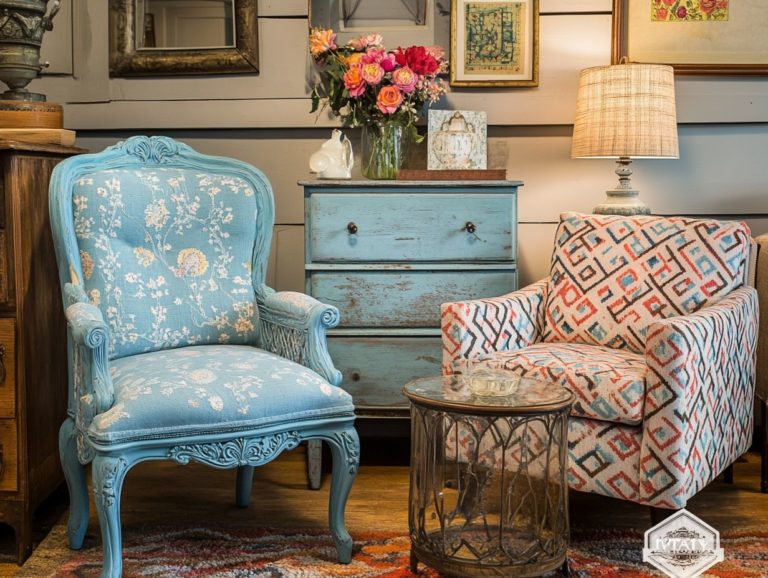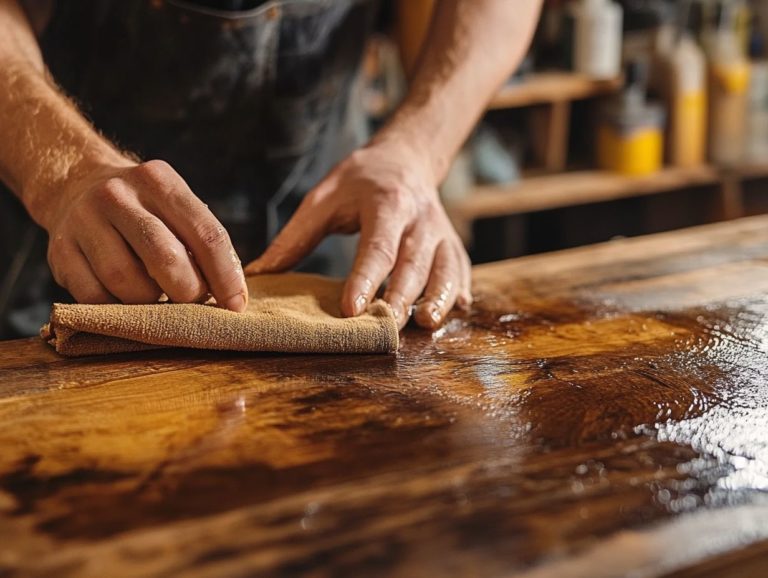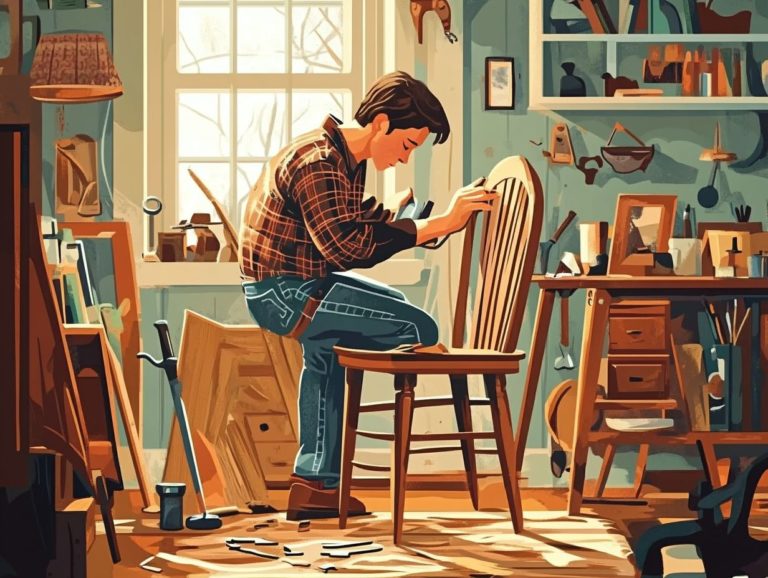DIY Restoration: Choosing the Right Fabrics
DIY restoration has the potential to turn tired furniture and spaces into breathtaking reflections of your personal style. A key component of this transformation is selecting the right fabrics, which not only enhance longevity but also elevate the overall aesthetics.
This article delves into the advantages of various fabric choices, covering everything from durability to maintenance considerations. You ll uncover the best fabrics for upholstery, curtains, and even clothing as you navigate the essential factors to keep in mind for your upcoming DIY project.
Get ready to transform your space today!
Contents
- Key Takeaways:
- Benefits of Choosing the Right Fabrics
- Key Factors for Choosing Fabrics
- Fabric Types for Every Project
- Frequently Asked Questions
- What is DIY restoration and why is choosing the right fabrics important?
- How do I determine which fabric is suitable for my DIY restoration project?
- Can I use any type of fabric for DIY restoration?
- What are some eco-friendly fabric options for DIY restoration?
- How do I know if a fabric is suitable for upholstery in DIY restoration?
- Can I mix different fabrics in one DIY restoration project?
Key Takeaways:

- Choosing the right fabrics ensures longevity and enhances aesthetics.
- Consider durability and maintenance when selecting fabrics for your projects.
- Various fabrics suit different restoration projects, such as upholstery and curtains.
What is DIY Restoration?
DIY restoration is your chance to roll up your sleeves and breathe new life into furniture. It allows you to personalize your space while maintaining both functionality and aesthetics for your indoor and outdoor pieces.
This hands-on approach opens up a realm of creative possibilities for those eager to rejuvenate tired items. Whether it s vintage chairs begging for a modern update or sofas yearning for fresh fabric, there s no shortage of projects awaiting your touch.
The choice of upholstery fabric is crucial; it should not only complement your design vision but also boast attributes like durability to handle daily wear and ease of maintenance for lasting beauty. Selecting the right fabric, be it a robust canvas for outdoor furniture or a luxurious velvet for your living area, can elevate both the visual charm and lifespan of your furnishings. For those interested in preserving vintage pieces, exploring the best vintage fabric restoration techniques can be invaluable.
DIY restoration supports sustainability by encouraging the reuse of existing pieces and reducing waste. By understanding fabric characteristics such as stain resistance and appropriate cleaning methods, you can make informed choices. Additionally, knowing how to choose vintage fabrics for upholstery allows you to seamlessly blend your style with practical needs.
Benefits of Choosing the Right Fabrics
Selecting the perfect fabrics for your upholstery projects is essential, as it significantly influences both durability and visual appeal of your furniture. Whether you’re furnishing an indoor space or an outdoor area, high-quality fabrics be they natural or synthetic can elevate the overall design while ensuring your pieces endure daily use.
The right choice not only enhances usability but also simplifies maintenance and boosts resistance to stains or fading. Therefore, it s imperative to give careful thought to your fabric selections during your shopping journey.
Longevity and Aesthetics
Longevity and aesthetics are paramount when you re choosing upholstery fabric. They directly impact how well your furniture will endure the test of time while still looking fabulous. High-quality fabrics, drawn from an exquisite array of swatches, not only promise durability but also invite creative expression through various upholstery styles and trends.
By grasping the unique characteristics of different fabrics, including their resistance to wear and tear, you can make informed choices that elevate both the visual appeal and functionality of your furniture.
When selecting upholstery, it s crucial to consider how different fabric types influence both longevity and visual allure. For instance, natural fibers like linen and cotton present a soft, welcoming look. In contrast, synthetic options such as polyester and nylon are celebrated for their durability and fading resistance.
Blends of these fabrics can perfectly marry aesthetic charm with resilience, making them an excellent choice for high-traffic areas. Understanding these dynamics enables more sustainable selections and plays a significant role in preserving your furniture s beauty for years to come.
Dive into your DIY project now and see how easy it is to breathe new life into your furniture!
Key Factors for Choosing Fabrics
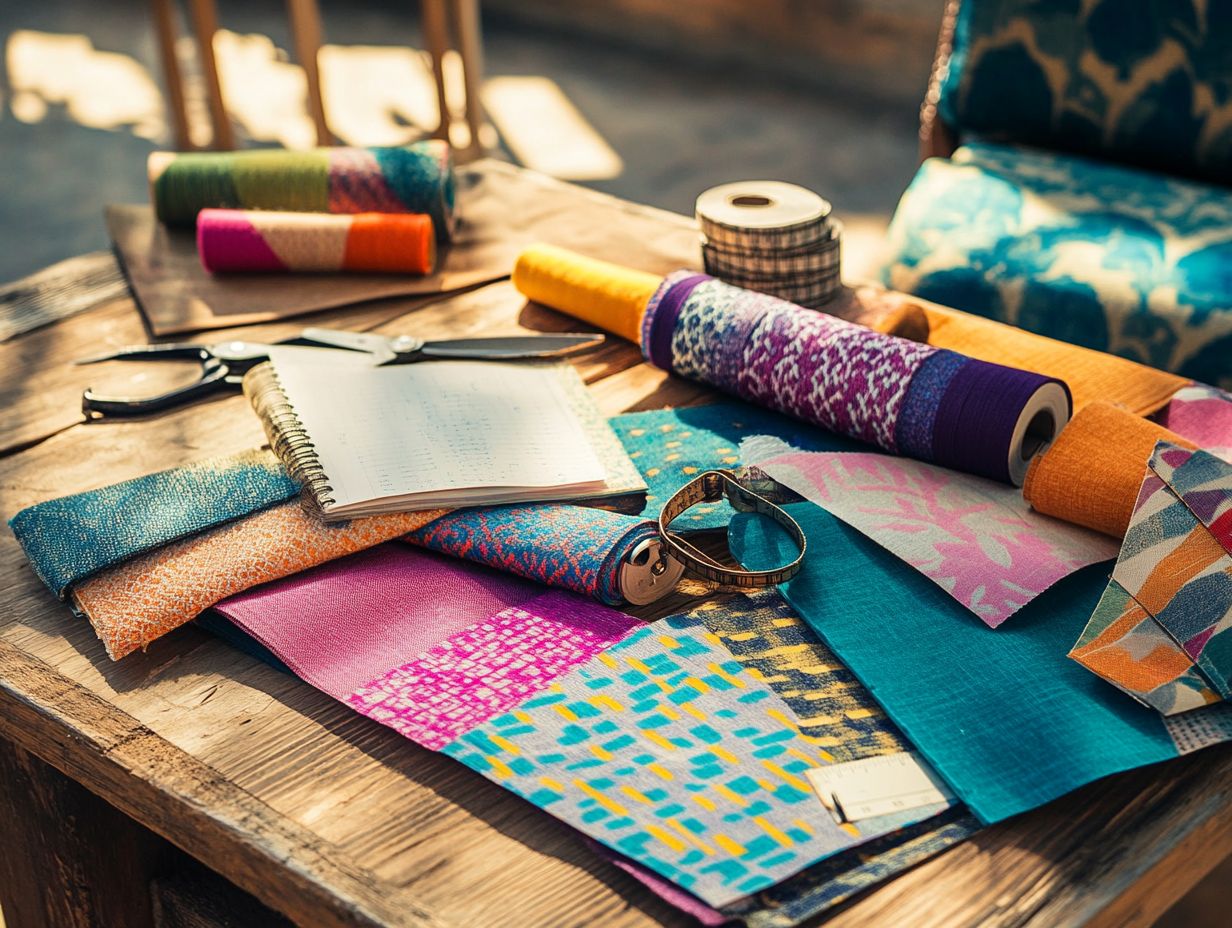
In the realm of upholstery projects, choosing the right fabric is a decision that involves important factors. These factors play a substantial role in durability, maintenance, and your overall satisfaction with the final result.
By grasping fabric characteristics such as weight, texture, and stain resistance, you will be well-equipped to select strong materials that are perfect for both indoor and outdoor furnishings.
Also, check elements like thread count, which refers to the number of threads woven together in one square inch of fabric. Conducting thorough fabric testing will ensure that your chosen material aligns with the specific quality and usability requirements of your project.
Durability and Maintenance
Durability and maintenance are essential when selecting upholstery fabrics. They dictate how well your furniture will endure wear and tear over time while remaining easy to care for.
Fabrics known for their strong qualities, like microfiber and vinyl, provide exceptional resistance to stains and fading. This makes the cleaning process a breeze.
When you understand the available options, you can make informed choices that align with your lifestyle and the specific demands of your upholstery projects.
Along with microfiber and vinyl, you ll find that fabrics like leather and canvas offer impressive durability, making them ideal for high-traffic areas.
Maintaining these upholstery choices requires regular vacuuming to remove dust and debris. Prompt attention to any spills can prevent staining.
Opting for fabrics treated with protective coatings can further extend their lifespan. By implementing these straightforward care techniques and selecting the right materials, you can beautifully blend style with practicality.
This ensures your furniture retains its elegance while withstanding the rigors of daily use. Imagine relaxing on a beautifully upholstered chair!
Compatibility with Furniture
When selecting upholstery fabric, compatibility with your furniture is crucial. It directly influences both functionality and aesthetic appeal.
Each upholstery style be it modern or traditional has specific fabric requirements to achieve successful reupholstering.
As a DIY upholstery enthusiast, you can draw inspiration from various sources. This enables you to select fabrics that align with your intended style and offer the durability necessary for the application.
The relationship between fabric selection and furniture style goes beyond mere visual allure. It encompasses comfort, maintenance, and overall longevity.
For example, a modern minimalist sofa may pair beautifully with lightweight linen, while a vintage wingback chair might call for thicker brocade to achieve that timeless touch.
When embarking on a reupholstering project, it s wise to consider factors such as the frequency of use and environmental conditions.
This ensures that your chosen fabric can withstand daily wear and tear. By mindfully merging aesthetics with practical choices, you elevate both the longevity of your furniture and your satisfaction with the final result.
Fabric Types for Every Project
Understanding the various types of fabrics available for your projects is crucial. This knowledge is key to achieving the best results in upholstery, whether for indoor furniture or outdoor furnishings.
Each fabric type, from natural to synthetic options, offers unique characteristics tailored to specific uses and environments.
By evaluating fabric swatches and seeking expert recommendations, you can make informed choices that elevate both functionality and style in your upholstery endeavors.
Don’t miss out! Start your upholstery project today and transform your space!
Best Fabrics for Upholstery
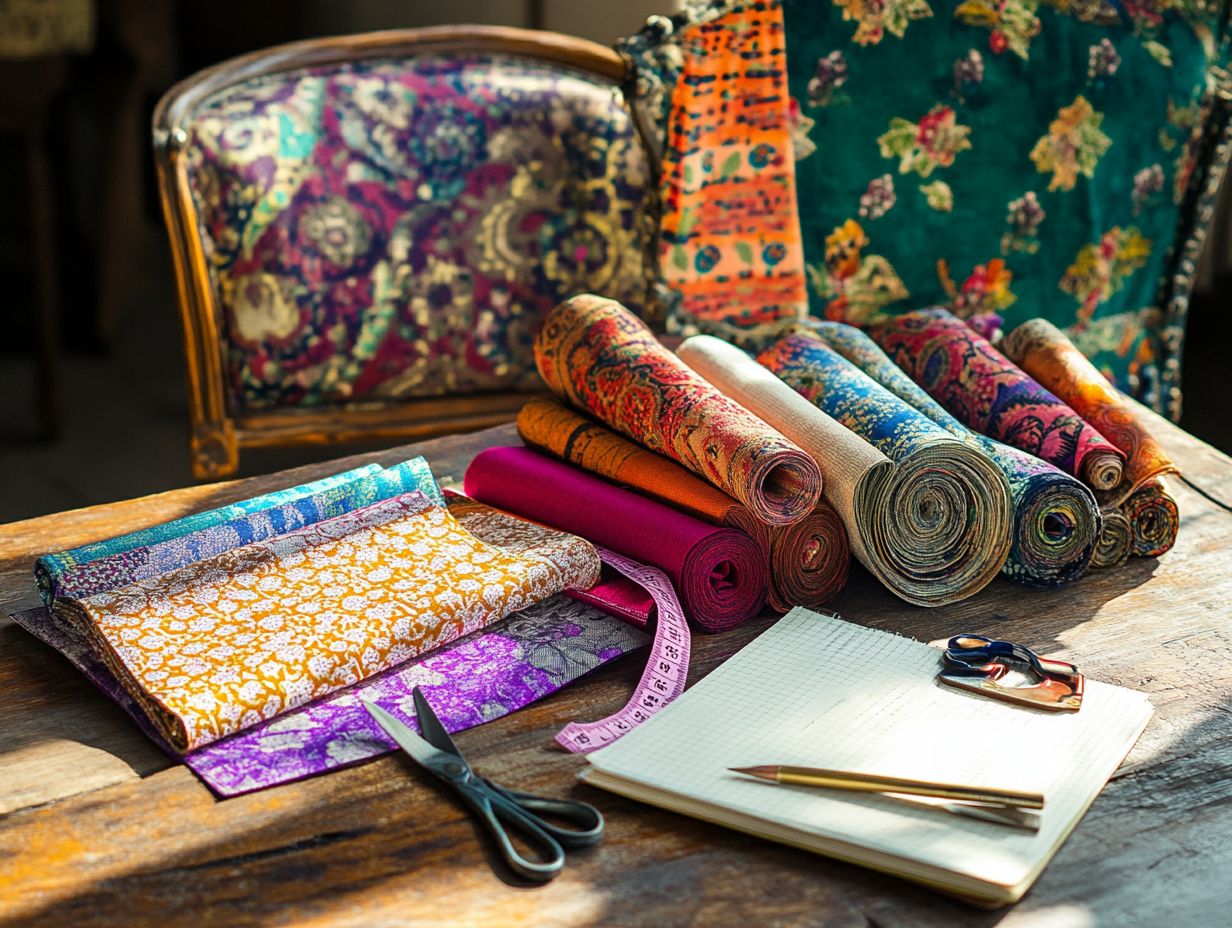
When reupholstering your furniture, selecting the finest fabrics is essential for ensuring durability, comfort, and a visually appealing aesthetic. Fabrics like microfiber, acrylic, and Sunbrella stand out for their exceptional durability and resistance to stains and fading, making them ideal choices for both indoor and outdoor upholstery projects. Opting for high-quality upholstery fabric can significantly enhance the longevity of your furniture while keeping it stylish.
These materials provide a variety of design options alongside outstanding wear resistance. They can withstand daily use and the spills that often accompany family life. Microfiber, with its very soft texture, resists stains and is a breeze to clean perfect for homes bustling with children or pets.
On the other hand, acrylic fabrics provide impressive UV resistance, ensuring those vibrant colors remain intact even in the sun’s relentless rays. And let s not forget Sunbrella fabrics, specifically engineered for outdoor settings, which keep your furniture looking fresh no matter what Mother Nature throws at it.
By understanding the unique properties of these fabrics, you can make informed choices that perfectly align with your lifestyle and decor preferences.
Top Choices for Curtains and Drapes
Selecting the right fabric for your curtains and drapes is crucial; it affects not only the aesthetic appeal but also the functionality of your window treatments. Linen, cotton blends, and polyester are fantastic choices that can really elevate your space!
Each fabric brings a variety of patterns and weights to the table, allowing you to customize light control and style to your liking. Paying attention to factors like color fastness will ensure your chosen fabrics maintain their vibrancy over time.
When choosing drapery fabrics, take a moment to assess your space. Heavier materials like velvet or brocade can impart a luxurious feel and offer excellent insulation ideal for those chillier climates.
Conversely, sheer fabrics provide a gentle wash of daylight while maintaining your privacy, making them perfect for sunnier locales. Don t overlook patterns; bold prints can act as eye-catching focal points, while subtle textures can enhance your overall design without stealing the spotlight.
Balance your design aspirations with practical needs, such as ease of maintenance and durability. This will lead you to a more satisfying and cohesive selection for your window treatments.
Recommended Fabrics for Clothing and Accessories
When selecting fabrics for your clothing and accessories, it s essential to choose materials that promise comfort and enhance the overall design and wearability. Fabrics like rayon, cotton blends, and lightweight linens are often recommended for their exceptional drape and texture, making them perfect for various fashion applications.
By grasping the unique properties of different fabric blends, you can craft stylish and functional pieces that cater to diverse tastes.
For example, a cotton-modal blend marries the breathability of cotton with the luxurious softness of modal, creating a fabric that drapes beautifully and feels heavenly against the skin.
Incorporating performance fabrics, such as moisture-wicking polyester blends, can elevate your athleisure collections, seamlessly combining functionality with style.
As you choose your materials, consider factors like seasonality and intended use. Lightweight, airy fabrics are ideal for summer styles, while heavier blends like wool or cashmere are perfect for adding warmth and sophistication to your winter wardrobe.
Ultimately, the right fabric can transform a design from ordinary to extraordinary, all while ensuring that comfort remains a top priority.
Frequently Asked Questions
What is DIY restoration and why is choosing the right fabrics important?
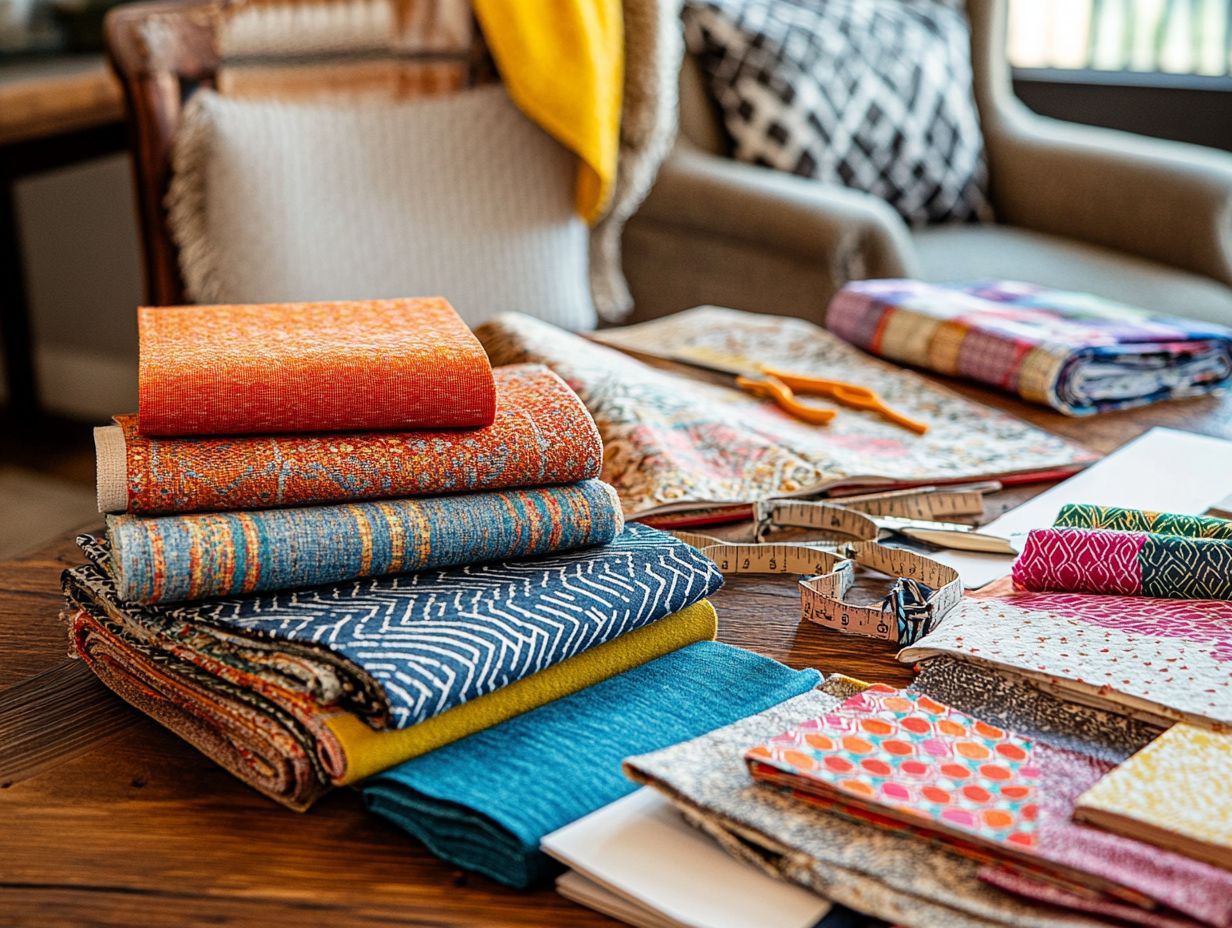
DIY restoration means fixing up old or worn items by yourself. Choosing the right fabrics is vital for ensuring durability and quality.
How do I determine which fabric is suitable for my DIY restoration project?
Consider the purpose and usage of the item you are restoring. If it will be frequently used, choose durable fabrics like canvas, denim, or twill.
For decorative items, opt for softer fabrics like cotton, linen, or silk. What project are you excited to start?
Can I use any type of fabric for DIY restoration?
No, not all fabrics are suitable for restoration projects. Avoid using fabrics that are too delicate or prone to shrinking or fading.
Always choose fabrics that are durable and can withstand wear and tear. Have you checked your fabric options?
What are some eco-friendly fabric options for DIY restoration?
Consider using sustainable fabrics like organic cotton, bamboo, or hemp! They not only help the planet but also ensure a fantastic finish for your projects.
These fabrics offer great quality and durability. Which eco-friendly fabric will you choose?
How do I know if a fabric is suitable for upholstery in DIY restoration?
When choosing fabrics for upholstery, look for fabrics with a high rating for wear and tear. This indicates that the fabric can withstand frequent use without showing signs of damage.
Can I mix different fabrics in one DIY restoration project?
Yes, you can mix and match different fabrics to add visual interest and texture. Just make sure to choose fabrics that complement each other in terms of color, texture, and durability.
Get creative! What combinations are you thinking about for your project?

